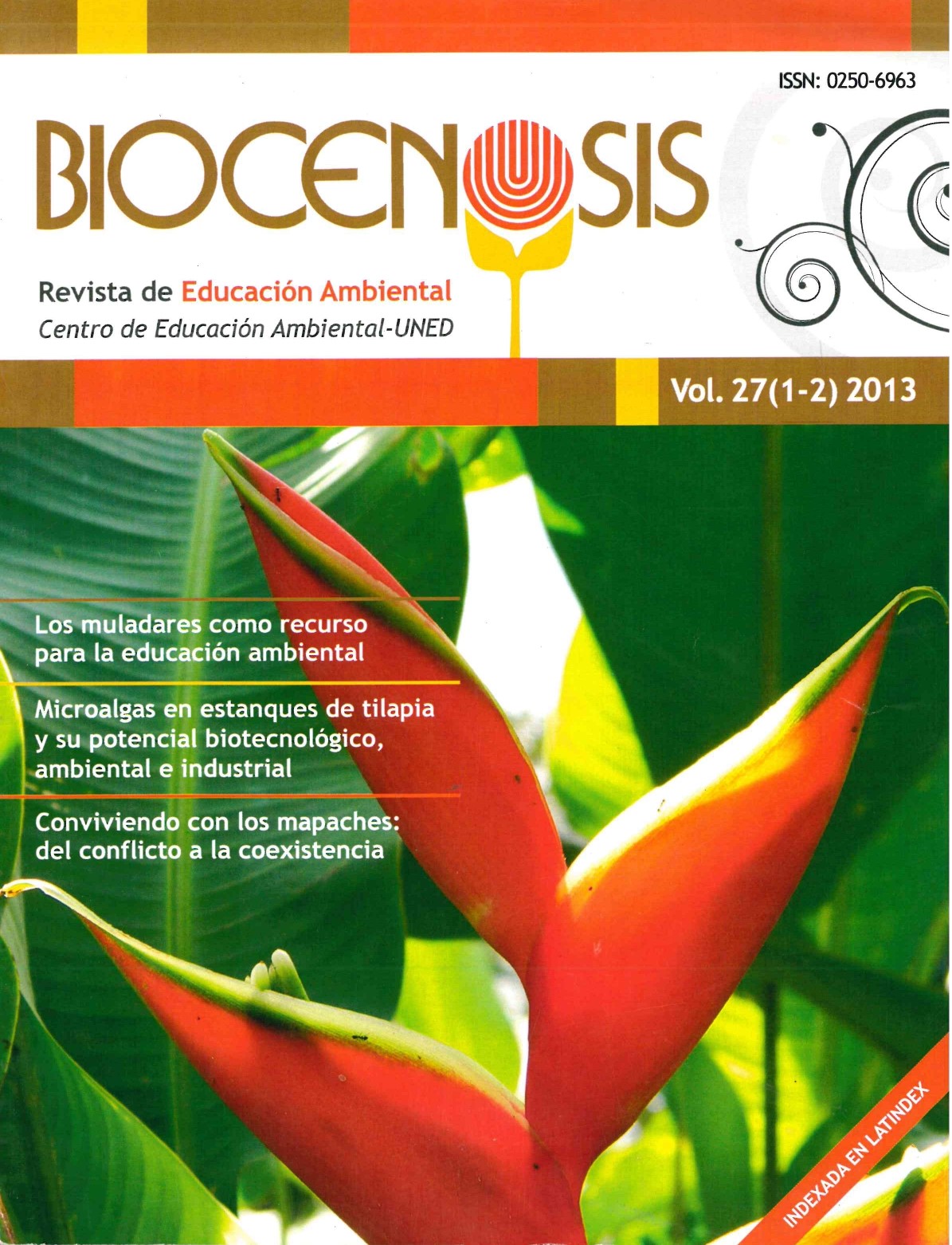Microalgas en estanques de tilapia y su potencial biotecnológico, ambiental e industrial
Palabras clave:
Microorganismos, Cianobacterias, Algas verdes, Cultivos de tilapiaResumen
Las microalgas han sido ampliamente estudiadas a nivel mundial, sin embargo en el trópico hacen falta más estudios relacionados con su identificación y posibles usos biotecnológicos. Los estanques de tilapias son ecosistemas artificiales con un alto potencial para la identificación de estas microalgas, debido a que sus condiciones físico-químicas son muy estables durante el año. En esta investigación se encontraron 31 especies de microalgas en los estanques de tilapia de la Estacion Biológica de 28 Millas en Limón, muchas de las cuales han sido reconocidas por sus aplicaciones biotecnológicas. Esto posiciona a Costa Rica, como un sitio en donde es posible encontrar microalgas de interés en esta línea de investigación.
Citas
Aguirre, P.; Álvarez, E.; Ferrer, I. & García, J. (2011). Treatment of piggery wastewater in experimental high rate algal ponds. Rev Latinoam Biotecnol Amb Algal, 2(2):57-66.
Campenni’ L.; B. P. Nobre; A. Santos; Oliveira, Aires- Barros, A. C., M. R., Palavra, A. M. F. & Gouveia, L. (2012). Carotenoid and lipid production by the autotrophic microalga Chlorella protothecoides under nutritional, salinity, and luminosity stress conditions L. Appl Microbiol Biotechnol (published online).
Chacón, C. Andrade, C. Cárdenas, C. Araujo, I. y Morales, E. (2004). Uso de Chlorella sp. y Scenedesmus sp. en la remoción de nitrógeno, fósforo y DQO de aguas residuales urbanas de Maracaibo, Venezuela. Boletín de Investigaciones Biológicas de La universidad del Zulia. Vol. 38. N° 2. 94 – 108.
Charity E., R. Andrade, Vera B, Alexandra I., Cardenas I, Carmen H and Morales A., Ever, D. (2009). Producción de biomasa de la microalga Scenedesmus sp. utilizando aguas residuales de pescadería. Rev. Téc. Ing. Univ. Zulia [online]. Vol.32, n° 2, 126-134
Craggs, R.; D. Sutherland & Campbell, H. (2012). Hectare-scale demonstration of high rate algal ponds for enhanced wastewater treatment and biofuel production. Appl Phycol 24:329–337.
Griesbeck, C.; Kobl, I., & Heitze, M. (2006). Chlamydomonas reinhardtii: A Protein Expression System for Pharmaceutical and Biotechnological Proteins r1. Molecular Biotechnology 34 213 – 223
Kaewkannetra, P., Enmak, P & Chiu, T. (2012). The Effect of CO2 and Salinity on the Cultivation of Scenedesmus obliquus for Biodiesel Production. Biotechnology and Bioprocess Engineering, 17: 591-597
López, A y Juana, S. (2005). La colección de microalgas dulceacuícolas y marinas de la Península de Yucatán. Universidad Autónoma de Yucatán. México.
Lopes da Silva, T., Reis, A., Medeiros, R., Oliveira, A. C., & Gouveia, L. (2009). Oil Production Towards Biofuel from Autotrophic Microalgae Semicontinuous Cultivations Monitorized by Flow Cytometry. Appl Biochem Biotechnol, 159:568–578
Martínez, V., A. Pellón, E. Pérez, O. Correa, R. Escobedo, Y. Madruga, A. Oña & Arencibia, R. (2005). Producción de biomasa de Scenedesmus obliquus en diferentes medios de cultivo. Rev. CENIC, Ciencias Biológicas. Vol. 36.N° Especial: 1-7.
Mata, T. M., Martins, A. A. & Caetano, N. S. (2010). Microalgae for biodiesel production and other applications: A review. Renewable and Sustainable Energy Reviews, 14 217–232.
Masojidek, J., Torzillo, G. (2008). Mass Cultivation of Freshwater Microalgae. In Sven Eril Jorgensen and Brian D. Fath. Ecological Engineering. Vol. 3 of Encyclopedia of Ecology. Oxford: Elsevier. 5 vols. Pp 2226-2235.
Masojıdek, J., & Prasil, O. (2010). The development of microalgal biotechnology in the Czech Republic. J Ind Microbiol Biotechnol, 37:1307–1317.
Martínez M, Sanchez, S., Jimenez, J. M., El Yous,F., Munoz, L. (2000). Nitrogen and phosphorus removal from urban wastewater by the microalga Scenedesmus obliquus. Bioresource Technology, 73: 263-272.
Meuser J, Ananyev G, Wittig L, Kosourov S, Ghirardi M, Seibert M, Dismukes G & Posewitz, M. (2009). Phenotypic diversity of hydrogen production in chlorophycean algae reflects distinct anaerobic metabolisms. Journal of Biotechnology, 142: 21–30.
Mishra P. K & Mukherji, S. (2012). Biosorption of diesel and lubricating oil on algal biomass. Biotech, 2:301–310.
Mustafa E.-M., Phang, S.-M & Chu, W.-L. (2012). Use of an algal consortium of five algae in the treatment of landfill leachate using the high-rate algal pond system. J Appl Phycol, 24:953–963.
Park, J.B.K. & Craggs, R.J. (2010). Wastewater treatment and algal production in high rate algal ponds with carbon dioxide addition. Water Science and Technology, 61, 633–639.
Peña Palacios, M. y Ospina-Alvarez, N. (2005). Algas como indicadoras de contaminación. Universidad del Valle. Colombia.164pp.
Pulz, O., & Gross, W. (2004). Valuables products from biothecnology of microalgae. Appl Microbiol Biotechnol, Vol. 65: 635 – 648.
Shi, W., Wang, L., Rousseau, P. L. &. Lens, P. N. L. (2010). Removal of estrone, 17α-ethinylestradiol, and 17ß-estradiol in algae and duckweed-based wastewater treatment systems. Environ Sci Pollut Res, 17:824–833.
Shukla D., Vankar, P.S. & Srivastava, S. K. (2012). Bioremediation of hexavalent chromium by a cyanobacterial mat. Appl Water Sci, 2:245–251.
Silva-Benavides A. M, Sili C & G Torzillo. 2008. Cyanoprocaryota y microalgas (Chlorophyceae y Bacillariophyceae) bentónicas dominantes en ríos de Costa Rica. Rev. Biol. Trop. Vol. 56 (Suppl. 4): 221-235.
Torzillo, G. (2008). Increased Hydrogen Photoproduction by means of a sulfur-deprived Chlamydomonas reinhardtii d1 protein mutant. International Journal of Hydrogen Energy.
Walker TL, Purton S, Becker DK, Collet C. 2005. Microalgae as bioreactors. Plant Cell Rep. 24(11):629-41.
Wang L., Min, M., Li, Y., P., Chen, Y., Liu,Y., Wang, Y. & Ruan,R. (2010). Cultivation of green algae Chlorella sp. in different wastewaters from municipal wastewater treatment plant. Appl. Biochem. Biotechnol.,162(4):1174-86.
Wehr J & Scheath, R. (2003). Fresh water algae of North America: Ecology and Classification. Academic Press. EE.UU. 918 pp.
Wydrzycka, U. (2009). Botánica General. EUNA. Costa Rica. 364 p.
Zhu, Ch., Chen, C,H., Zhao, L., Zhang, Y., Yang, J., Song, L., & Shao Yang (2012). Bioflocculant produced by Chlamydomonas reinhardtii. J Appl Phycol, 24:1245–1251.
